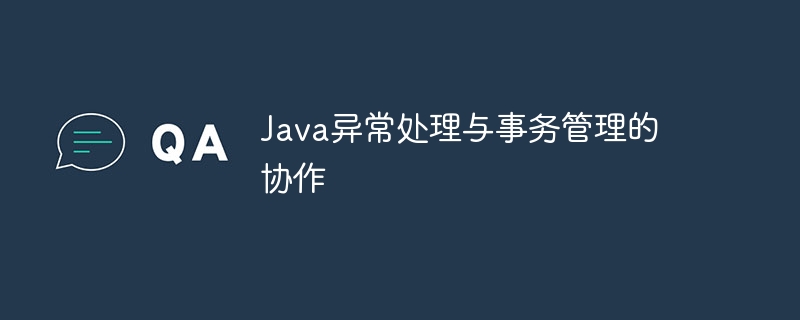Home >Java >javaTutorial >Collaboration of Java exception handling and transaction management
Collaboration of Java exception handling and transaction management
- WBOYWBOYWBOYWBOYWBOYWBOYWBOYWBOYWBOYWBOYWBOYWBOYWBOriginal
- 2024-05-01 13:33:02670browse
Java exception handling and transaction management work together to ensure application reliability under abnormal conditions. Exception handling aims to manage unexpected events, while transaction management ensures ACID properties of data operations. Proper coordination involves: 1) catching the exception within the transaction; 2) rolling back the transaction when the exception prevents the transaction from completing; 3) rethrowing the exception to propagate the error under certain circumstances. Through collaboration, errors can be handled gracefully while maintaining data consistency.

Collaboration of Java Exception Handling and Transaction Management
Introduction
In Java In applications, exception handling and transaction management are key mechanisms for handling errors and maintaining data consistency. It is critical that these two mechanisms work together correctly to ensure that the application behaves reliably when exceptions occur.
Exception handling
Exception handling is a way for applications to handle unexpected events and abnormal conditions. Java exceptions are represented by the Throwable class or its subclasses such as Exception and RuntimeException. Exceptions contain error-related information and can be used to determine appropriate recovery actions.
Transaction Management
Transaction management is used for data operations that ensure atomicity, consistency, isolation, and durability (ACID) properties. A transaction is a set of logically related operations that should be processed as a whole. Either all operations complete successfully, or all operations are rolled back, returning the application to the state it was in before the exception occurred.
Collaborative exception handling and transaction management
1. Catching exceptions in transactions:
In transactional methods, Any thrown exception should be caught. This will prevent exceptions from propagating outside the scope of the transaction, causing the transaction to be rolled back.
Code example:
try {
// 执行事务性操作
} catch (Exception e) {
// 在此处处理事务中抛出的异常
}2. Roll back the transaction in response to an exception:
If the exception is caught in the transaction Successful completion of the transaction is prevented and the transaction should be rolled back. This will undo any actions that have been performed, making it as if the transaction never occurred.
Code example:
try {
// 执行事务性操作
} catch (Exception e) {
try {
if (transaction.isActive()) {
transaction.rollback();
}
} catch (Exception e2) {
// 处理回滚事务期间发生的异常
}
}3. Rethrow the exception to propagate the error:
In some cases, Exceptions caught within a transaction may not be suitable for the application to continue running. In this case, the exception should be rethrown to propagate the error outside the transaction scope.
Code example:
try {
// 执行事务性操作
} catch (SomeSpecificException e) {
throw e;
}Practical case
Consider a transfer scenario in a banking application:
- Transfers deduct funds from one account (source) and add funds to another account (destination).
- We will create a transaction method to do this.
public void transferFunds(int fromAccount, int toAccount, int amount) {
EntityManager em = getEntityManager();
em.getTransaction().begin();
try {
// 获取源账户和目标账户
Account sourceAccount = em.find(Account.class, fromAccount);
Account targetAccount = em.find(Account.class, toAccount);
// 扣除源账户的金额
sourceAccount.setBalance(sourceAccount.getBalance() - amount);
// 将金额添加到目标账户
targetAccount.setBalance(targetAccount.getBalance() + amount);
em.getTransaction().commit();
} catch (Exception e) {
if (em.getTransaction().isActive()) {
em.getTransaction().rollback();
}
throw e;
}
}In this case, any exception caught within the transaction will trigger a transaction rollback, ensuring that the account balance remains consistent after the exception occurs.
The above is the detailed content of Collaboration of Java exception handling and transaction management. For more information, please follow other related articles on the PHP Chinese website!

